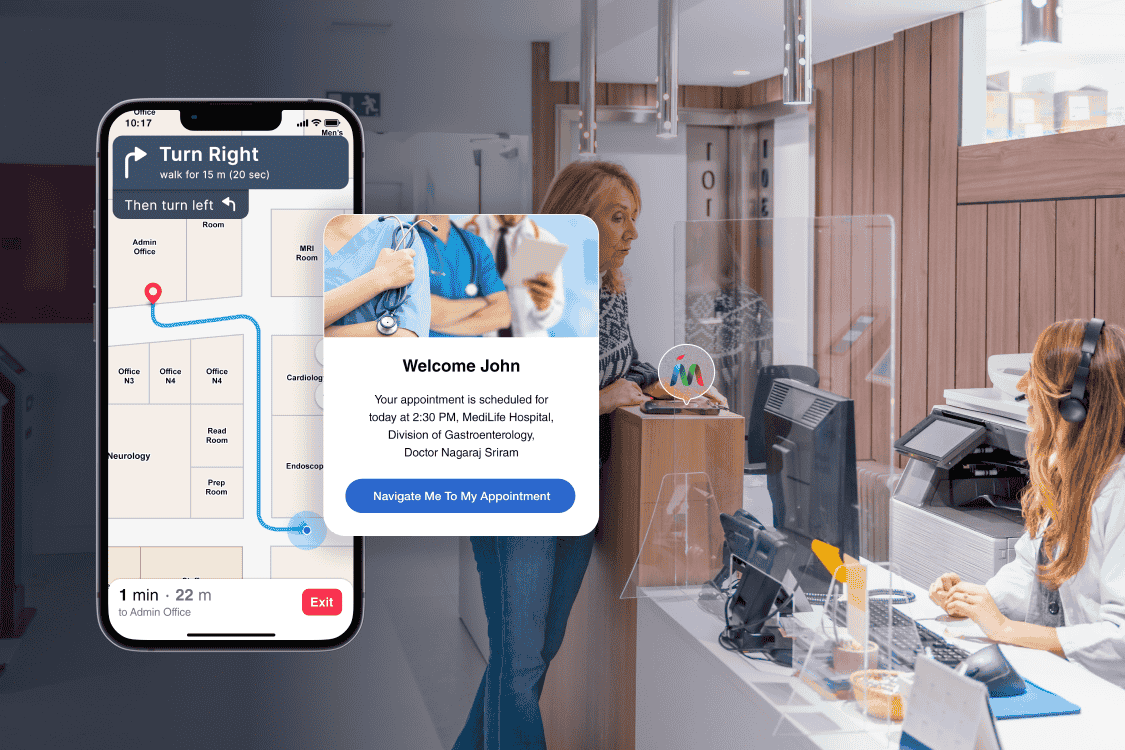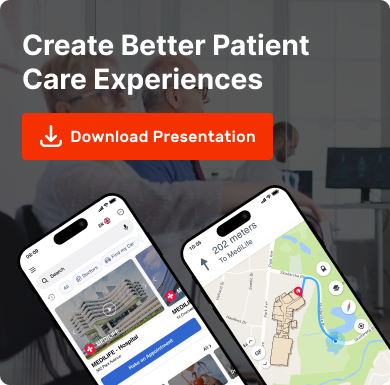Hospitals & Healthcare

Hospitals aren’t just places of care—they’re also complex, high-pressure environments where every second counts. For hospital owners and administrators, improve patient experience with wayfinding technology is no longer optional. Patients today demand ease and efficiency and a single frustrating experience—whether it’s getting lost, missing an appointment or struggling to navigate the facility—can tarnish a hospital’s reputation and drive patients away. This is where Mapsted’s indoor wayfinding technology in hospitals and location-based solutions come in.
But before we go into details let’s understand a scenario:
Consider this: A mother arrives at a busy hospital holding her crying toddler, showing signs of being in pain. She’s anxious and simply wants to reach the pediatric unit where they have an appointment. But once she walks through the door, her anxiety surges. The signs are hard to read, the hallways all look alike and she has no idea where she is going. Even locating a parking space earlier nearly caused a panic.
By the end of the visit, she is exhausted. And after searching her way down confusing hallways and waiting rooms, she now roams the parking lot, unable to remember where she parked. It’s the last straw on top of an already stressful day, leaving her feeling frustrated and emotionally drained.


This isn’t an uncommon experience. Patients and their families face similar challenges every day in hospitals. For them, navigating a hospital means more than just finding their way physically — they feel lost, rushed and unheard. For hospitals, this creates serious consequences — they lose visits, see satisfaction drop and watch patients choose competitor organizations that focus on the whole-person experience. And it’s a problem that no cutting-edge technology or well-trained staff will solve unless you fix how patients flow through your facility.
Creating a Wholesome Experience: From Entrance to Exit
First impressions matter, especially in healthcare. From the moment a patient steps onto hospital premises to the time they leave, every interaction shapes their perception of your facility. A cohesive, well-designed experience can convert a first-time visitor into a loyal patient who recommends your hospital to family and friends. Here’s how Mapsted helps you deliver at every touchpoint:
1. Welcoming Patients with Smart Technology
The experience begins the moment a patient enters the premises. With Mapsted’s indoor navigation technology:
- Patients receive a welcome message on their smartphones, instantly making them feel acknowledged and supported.
- Step-by-step Blue Dot Navigation provides clear, turn-by-turn directions from the entrance to their destination—be it a doctor’s office, diagnostic lab or cafeteria.
- Interactive maps highlight key amenities like restrooms, elevators or pharmacies, ensuring patients can find what they need easily.
- Routes are optimized for accessibility, including wheelchair-friendly paths and voice-guided multi-language navigation.
Navigational issues are not just a minor inconvenience—they’re costly. Research highlighted by the Journal of PeriAnesthesia Nursing estimates that wayfinding in hospitals could cost up to $220,000 annually.
Navigational issues are not just a minor inconvenience—they’re costly. Research highlighted by the Journal of PeriAnesthesia Nursing estimates that wayfinding in hospitals could cost up to $220,000 annually.
Addressing these problems with tools like Mapsted’s can eliminate inefficiencies while improve patient experience with wayfinding technology.
2. Geofencing for Tailored Messaging
Geofencing helps hospitals send hyper-targeted messages to patients and visitors based on their precise location within the facility. This capability can transform how hospitals communicate with patients by:
- Sending real-time directional cues like, “Turn right for the restroom” or “Head left to collect your lab test results.”
- Highlighting nearby services with promotions, such as “20% off on medicines at the pharmacy nearby.”
- Informing patients about hospital amenities, like, “The cafeteria is just ahead on your right,” or “Pick up your imaging reports here.”
- Enabling location-based marketing to enhance patient engagement and increase revenue opportunities.
3. Efficient Resource Management with Asset Tracking
It’s all about operational efficiency and that’s where a positive patient experience comes in. Here’s what you can be assured of with Mapsted asset tracking:
- Medical personnel can quickly locate IV pumps or diagnostic tools, for example, to provide prompt care.
- Keeping track of inventory is simple, preventing the risk of misplaced or lost equipment.
- Staff time is better utilized, as they spend less time searching and more time providing care.
4. Heatmaps for Better Resource Allocation
Understanding patient movement patterns can help hospitals optimize their resources. With Mapsted’s heatmap analytics:
- Identify high-traffic areas and deploy additional staff where needed most.
- Optimize patient flow to reduce congestion and minimize wait times.
- Gain actionable insights to improve long-term planning and decision-making.
5. Post-treatment convenience with Vehicle Location Assistance
The journey doesn’t end after the appointment. Patients often find themselves stressed trying to locate their parked cars. Mapsted solves this by:
- Automatically tracking the parking location so patients can easily navigate back to their vehicles.
- Providing step-by-step directions, even in large or multi-level parking areas, ensuring a smooth exit.
- Sending follow-up notifications with helpful information like pharmacy operating hours or post-treatment guidelines, reinforcing trust and care.
The Business Case for Location-Based Technology
Investing in Mapsted’s solutions isn’t just about improving the patient experience with wayfinding technology—it’s about delivering measurable ROI. Here’s how:
- Higher patient retention: An easy, hassle-free visit guarantees that patients come back for subsequent treatment and refer the facility to others.
- Less staff burden: Because fewer patients require this direction, staff are freed for more value-added work.
- Reduced operational costs: The removal of hardware reduces costs associated with implementation and maintenance.
- Revenue generation: Use of contextual notifications drives traffic to hospital services (e.g., cafeterias, parking, or wellness programs).
Addressing Common Concerns
“Is It Difficult to Implement?”
Mapsted uses minimal hardware with its solutions, which is designed to be easy to implement. And, unlike some legacy systems, there’s no hectic installation or maintenance required, so deployment is smooth and worry-free.
“Will this Compromise Patient Privacy?”
Patient confidentiality is absolutely sacrosanct. All your data is secured in accordance to HIPAA & GDPR policies with Mapsted’s high data protection standards. Everything is anonymous, protecting consumers.
“Is it Scalable?”
Absolutely. Whether your hospital is a single building or a multi-campus facility, Mapsted’s technology scales effortlessly to meet your needs.
Why Hospitals Can’t Ignore This Opportunity
In the highly competitive healthcare world, patient expectations are higher than ever. Hospitals must provide amazing experiences, not just treatment, in order to succeed today. Adopting hospital wayfinding design and indoor wayfinding technology is a right way to improve patient experience with wayfinding technology in hospitals. It’s a necessity in a patient-driven market.
Mapsted scales beautifully, coming with a proven track record, yielding cost-savings, while enhancing the patient journey and driving operational performance & sustainable loyalty.
Conclusion
It is time to bring your facility up to speed. Step forward and experience how Mapsted can transform your hospital in line with patient-centered care.
Schedule a demo now and discover the future of hospital navigation. If you found this blog helpful, please read our blog on Building the Future of Healthcare: Hospital Design Trends or watch our video on Transform Patient Care and Healthcare Facility Efficiencies With Location-Based Technology to learn more.
Frequently Asked Questions
Q1. How does Mapsted improve patient navigation in hospitals?
Ans. It provides turn-by-turn directions on smartphones, directing patients to the department, lab or pharmacy they’re trying to reach.
Q2. Can Mapsted reduce wait times in busy hospital areas?
Ans. Yes, heatmap analytics assist hospitals with recognizing crowded areas and putting the right staff in the right places to decrease a patient’s wait.
Q3. How does geofencing enhance patient communication?
Ans. Geofencing helps in marketing. With notifications regarding discounts on medical tests, price drops on medicine and healthcare products to the people in the zone helps to generate revenue.
Q4. Is Mapsted’s technology easy to implement in hospitals?
Ans. Absolutely, It needs minimal hardware, so there’s no need for beacons or complicated installations, so deployment is fast and economical.
Q5. Does this technology ensure patient data privacy?
Ans. Mapsted strictly follows HIPAA and GDPR standards so that patient information is anonymized and secured.
